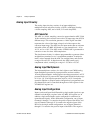
Chapter 3 Theory of Operation
©
National Instruments Corporation 3-9 AT-MIO-16X User Manual
When the ADC value is shifted into the ADC FIFO buffer by
FIFO_LD*, a signal is generated that indicates valid data is available to
be read. Single conversion timing of this type is appropriate for reading
channel data on an ad hoc basis. However, if a sequence of conversions
is needed, this method is not very reliable because it relies on the
software to generate the conversions in the case of the strobe register.
If finely timed conversions are desired that require triggering and
gating, then it is necessary to program the board to automatically
generate timed signals that initiate and gate conversions. This is known
as a data acquisition sequence.
A data acquisition operation refers to the process of taking a sequence
of A/D conversions with the sample interval (the time between
successive A/D conversions) carefully timed. The data acquisition
timing circuitry consists of various clocks and timing signals. Three
types of data acquisition are available with the AT-MIO-16X board:
single-channel data acquisition, multiple-channel data acquisition with
continuous scanning, and multiple-channel data acquisition with
interval scanning. All data acquisition operations work with pretrigger
and posttrigger modes with either internal or external timing signals.
Pretriggering acquires data before a software or hardware trigger is
applied. Posttriggering acquires data only after a software or hardware
trigger is received.
Single-Channel Data Acquisition Timing
The sample-interval timer is a 16-bit down counter that can be used with
the six internal timebases of the Am9513A to generate sample intervals
from 0.4 µsec to 6 sec (see the Timing I/O Circuitry section later in
this chapter). Conversion intervals of less than 10 result in an overrun
condition. Counter 3 of the Am9513A Counter/Timer is used to
generate conversion interval timing signals. The sample-interval timer
can also use any of the external clock inputs to the Am9513A as a
timebase. During data acquisition, the sample interval counts down at
the rate given by the internal timebase or external clock. Each time the
sample-interval timer reaches zero, it generates an active low pulse and
reloads with the programmed sample-interval count, initiating a
conversion. This operation continues until data acquisition halts.
External control of the sample interval is possible by applying a stream
of pulses at the EXTCONV* input. In this case, you have complete
external control over the sample interval and the number of A/D
conversions performed. All data acquisition operations are functional
with external signals to control conversions. This means that in a data


















